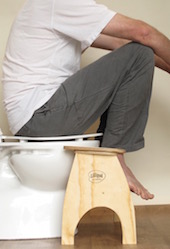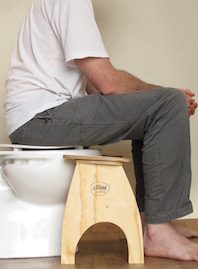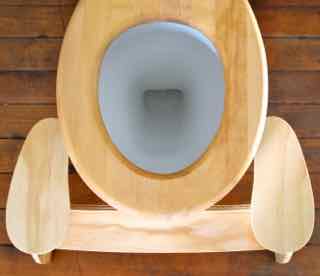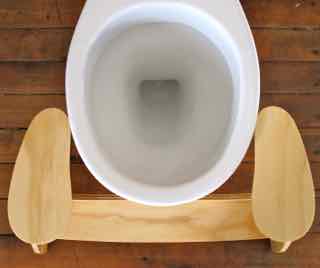If I am already comfortable with squatting on a toilet rim, what benefit does the Lillipad provide?
When returning from holiday and squatting on the rims of toilets, I can honestly say that it is a relief to use the Lillipad at home. The Lillipad is stable, there is no ‘digging in’ of the rim on your feet or struggle for balance. Therefore, you can truly relax and don't have to rush things. It was the awkwardness of squatting on the rim that led me to develop the Lillipad in the first place.
Do you have any thoughts on how the Lillipad compares to other products?
The Lillipad facilitates a complete squat, and its step allows a squat-like posture for the less flexible. The rim of the toilet can be used in conjunction with the Lillipad to raise the heels slightly and facilitate a narrower squat. The Lillipad is not in the way if someone wants to sit.




Sitting with your feet up is not squatting, see for yourself in the photos. Some products, such as the Lillipad footstool, are only footrests which allow you to lean forward and raise your feet. On these products it is impossible to adopt a complete squat because the toilet bowl is in the way.
Squatting is a graceful yoga pose achievable without props — it is this posture which is studied for its health benefits.
The ability to aim successfully is worth considering — the Lillipad takes the approach of placing the user lower and tilting them forward to make aiming when urinating easier — especially so for women. To facilitate a wider stance the Lillipad comes with adjustable footpads that slope slightly downwards, and tilt towards each other. For a narrower stance you can place your heels on the rim of the toilet and your toes on the footpads.
People like the step on the Lillipad for putting their feet on — a good introduction to the squat. Children can use the step to gain access to the lowered toilet seat which they can squat on. They can also access the flush button! Being lower than some products and having a step, the Lillipad is easier to get on and off for more people.
The legs of the Lillipad angle out for stability. The footpads fall inside the feet of the Lillipad, this is good design enabling you to balance your weight on one footpad without it tipping — it is very stable.

The footpads adjust so you can position them for your comfort, and you can shift the Lillipad forwards or back to suit. If you have big feet (like mine) your toes simply hang over the front edge.
There is no need to remove the Lillipad so another person can use the toilet in the sitting position, nor replace it when one wants to squat. The weight of the Lillipad is a little over two kilos.
Many of our customers comment about the attractive design, functionality, and craftsmanship of the Lillipad (Click on Lillipad reviews in the bar above and read for yourself). Feedback from our customers since 1991 has been integral to honing the Lillipad’s design.
When comparing cost consider functionality and how often you will use it. A friend has had their’s in daily use for 29 years! Note too that the Lillipad already includes delivery in the price.
The Lillipads are proudly made in New Zealand, in a workshop — not a sweatshop or plastics factory : )
The plans for sale on the order page offer a great, very affordable, DIY alternative to the Lillipad.
It feels odd comparing the Lillipad with other products as we are all on the same team promoting healthier toilet posture. I’m proud to have had an influence in this regard.
Do you provide any warranty?
If the Lillipad goes missing or is damaged in transit there is insurance cover for a replacement (there is a tracking number on the parcel).
As a result of hygiene issues a refund or exchange is only available for the Lillipad if it has a structural fault. This must be brought to our attention within 30 days of receiving the Lillipad.
If the Lillipad is returned unopened and in original condition, we will deduct our shipping and handling expenses and make a prompt refund.
This warranty does not affect New Zealanders’ rights under the Consumer Guarantees Act (NZ) or the Fair Trading Act (NZ).
New Zealand’s legal jurisdiction applies to the transaction.
We recommend people practice the squat position before they purchase, and are prepared to give squatting on the Lillipad a few weeks to get used to. The video on this website shows how to easily get on and off the Lillipad.
To improve our already personal level of service please let us know first if you have any concerns.
Do you have a privacy policy?
Lillipad Limited respects your privacy. We will only retain the information you volunteer when you place an order.
We do not share this information with anyone else.
Our payment method is via PayPal, an online payment service who use the latest anti-fraud technology, we never see you bank or credit card numbers.
Is there a legal disclaimer?
Legal Disclaimer
People prone to dizziness or loss of balance should hold onto a secure handle or chair placed in front of the toilet when using the Lillipad.
The Lillipad is not guaranteed to prevent or cure any particular ailment. Information in this website should not be a substitute for qualified medical advice.
Is the Lillipad portable?
Yes, especially the height adjustable model! The Lillipad weighs just two kilos (4.½ lb.) and will easily fit in the back of the car.
The short and height adjustable Lillipads will fit into a cardboard box or even a suit case with a depth greater than or equal to 282 mm (11⅛ in.)
a width greater than or equal to 555 mm (21¾ in.)
and a height greater than or equal to 330 mm (13 in.)
The tall Lillipads will fit into a cardboard box or even a suit case with a depth greater than or equal to 285 mm (11¼ in.)
a width greater than or equal to 565 mm (22¼ in.)
and a height greater than or equal to 385 mm (15¼ in.)
We are worried our 2 year old and 5 year old will not feel stable on it. If you have any suggestions, we welcome them!
If your children would like to try squatting then in their own way and time they can do so with the assistance of the Lillipad. The Lillipad will make the toilet (including the flush button) more accessible for your children and is very stable when approached from the step and when squatting on the footpads.
Toilets are designed to accommodate the weight of the heaviest people. A five year old is light and flexible enough to squat on the toilet seat, or on the rim of a toilet in good condition. In their own time they can migrate to the Lillipad. Some children never sit and continue as adults to use toilets this way. Shoulder width is a good indication of how wide ones feet can be when squatting ― especially so when young and supple.


For your two year old a toilet seat insert and supervision may be suitable. When they are ready, start out by squatting down and holding onto their arms. A handle, bathroom furniture or the back of a chair may help them with balance.
I would suggest not rushing your 2 year old and finding a suitable long flat narrow bowl (something from the plastic recycling with a piece of toilet paper laid in it). Consider using an old toilet seat and cutting a slot in the cover to the seat with a jigsaw and appropriate blade. The width of the cut could be 100 mm (4 in.) wide and as long as the hole in the seat below allows. Mark carefully with a pencil rounding the corners and cut to the inside of your line. Sand to the line for a smooth finish.
If your children prefer to sit at least they will be able to rest their feet on the step and have something to push against, or they could lean forward into a sitting — squat.
“Thank you. It arrived today and have already caught my 4 year old squatting on it! He was very excited and it looked completely natural for him.” Sara, (NZ)
“Got the platform right after Christmas. Put it together a week later. It was easy (my 5 year-old daughter helped). Though it took me a few tries to really trust the stability of the Lillipad, because of the lightweight construction, I am now happily squatting and enjoying the already obvious benefits — along with my wife and two kids, who are now former skeptics.” Bruce, (Germany)
“Received and all assembled...kids say they think its crazy but have spied them using it!
Thanks again Alexis,” (Australia)
“I just wanted to let you know that we got the Lillipad without any
problems, and that wow, it is a beautiful piece of work! It's just really
well designed and made (nice wood!). I appreciate its stability too,
especially as it doubles as a stool for our 2 year old. It's more stable
than the stool I had before for her to climb onto the toilet. She now
enjoys climbing onto her mini-toilet seat she can close down herself, and
puts her feet on the Lillipad for fun. One day she made a library out of
it, bringing her "little stool" (the normal one she used to use) in front
of it, and a handful of books. She sat on the Lillipad step and read some
books on the other stool. There's a new use for it!
As for us, we're adapting to frog life over the toilet ;) I believe that
squatting is the proper way for the body to eliminate, so it's nice to
have the Lillipad. I do have to hang onto something myself, as I'm in my
37th week of pregnancy, and easy prey to be toppled over.
So thanks for your Lillipad! Wonderful product!”
Yael, (USA)
The distance from the floor to the top of the rim of the bowl is 15 inches (381 mm) right on the border between short and tall. Are there other considerations in choosing the short or tall Lillipad?
If you already squat on the rim of the toilet and have no problems aiming to urinate then I would suggest the tall — you will be able to position your heels closer together with your feet flatter using the rim of the toilet. Women will find it a bit easier to aim when urinating on the shorter model as they are positioned lower to the bowl. In this situation we recommend the The height adjustable Lillipad.
When you first step on to it, using one foot at a time, how do you keep it from tipping to the side before your second foot is on?
The best way to get onto the Lillipad is to step backwards placing the toes of one foot onto the front inside section of a footpad.
Squat down until the heel of your foot rests on the footpad and your full weight is supported by that foot, then lift the other foot into position.
Placing the toes of one foot onto the front inside section of a footpad is the key to avoiding the tipping as the weight is transferred to all four feet of the Lillipad. When looking straight down on the Lillipad you will notice that the edges of the footpads fall inside the feet of the Lillipad, this is good design enabling you to balance your weight on one footpad without it tipping — It is very stable.
Do you touch or sit on the rim of the toilet when using the Lillipad?
If you squat fully on the footpads you won’t touch the toilet at all, but you can position the heels of your feet so they rest on the rim of the toilet and your toes rest on the footpads of the Lillipad. You may even be able to sit on the toilet seat with your feet on the foot pads, or even sit with your feet up on the toilet-step. That’s the beauty of the Lillipad — there are many ways to use it.
When using the Lillipad, are you positioned far enough back to urinate easily?
You can easily position yourself forwards or backwards on the Lillipad (or the Lillipad itself before getting on to it). When squatting fully on the Lillipad the user is tilted forward and closer to the bowl, this facilitates urination — especially for women. Men will be able to aim as usual.
Is splashing a problem?
No more so than sitting — but you can put a piece or two of toilet paper in the toilet bowl to prevent it. Feedback from one customer suggests cutting appropriate strips from the local newspaper for 100% success!
Can people with big feet use the Lillipad?
I'm 6 foot 5 and I've got feet to match, one’s toes just hang over the front and if you are wearing shoes there is support from the sole of the shoe, it's really not a problem. If you chose to squat with the heels of your feet resting on the rim of the toilet, the Lillipad can be positioned to support your toes - no matter what your shoe size. If you click on the ‘how to use the Lillipad’ link you can see me with feet on the footpads.
Is slippage a problem?
The footpads have a slip resistant have a matt finish. Slippage only seems a problem if you are wearing socks (woollen or nylon). It seems a lot of problems (in life in general) are bigger in our imaginations than they are in reality. People think bathrooms are wet places but in reality they aren't really. If a problem exists you could wear some rubber-soled house shoes.
Our toilet is 41 cm high to the rim, if we get a lower toilet in the future would we be able to cut the Lillipad down?
If necessary, when you shift, the Lillipad can be cut shorter. Stand the Lillipad on a flat surface. Lay a sharp pencil on its side. Pack under the pencil (use a matchbox, book, etc) up to the thickness you wish to reduce the height of the Lillipad by. Carefully mark a pencil line on all sides of the bottom of each leg parallel to the surface. Cut just to the waste side of the line — not on it. Or you could take the Lillipad to a woodworker.
Space is tight-how can I store the Lillipad?
You could hang the Lillipad from the wall or the back of a door. Tie a piece of string around the step and hang it onto a firmly secured hook, the Lillipad weighs only 2 kilos (4½ lb.) Maybe you could find a shelf for it.
Does the plywood contain formaldehyde?
Formaldehyde occurs naturally in wood. The Phenol Formaldehyde glue used is the lowest emitter, called Super Eo. There is a 0.3 mg/l formaldehyde emission from the glue I use compared to 0.1 mg/l formaldehyde emission from natural wood. The wood is untreated and it is the best quality locally made plywood we can buy in New Zealand.
What finish is used on the Lillipad?
We use ‘Rustins’ danish oil, here is some information from their fact sheet.
Danish Oil is a special formulation developed by Rustins Ltd. (founded in 1924) based on Tung Oil, also known as Chinese Wood Oil. The oil is extracted from nuts, similar in size to a Brazil nut, growing on species of trees found mainly in China and some areas of South America.
After processing the oil is blended with synthetic resins to improve hardness, and other vegetable oils. Driers and solvents are added to improve the performance and application properties, so that Danish Oil may be applied with a rag or brush.
The special ingredients used in the manufacture of Danish Oil penetrate deep into all types of timber, drying to a hard, durable and water resistant seal. Unlike varnishes it does not leave a thick film on the surface which may peel, chip or craze on ageing.
The finish stands up to chemical cleaners, and is easily maintained by re-oiling as required every couple of years (in a well ventilated area and left to dry and air in the sun). Before re-oiling; clean the surface with a mild detergent solution, rinse and dry, or clean with steel wool, white spirit and a clean rag.
Can the Lillipad be painted or varnished?
Yes, you can apply any good quality oil based varnish or paint over ‘Rustins’ danish oil (which can be used as a primer).
Please follow the directions of the paint manufacturer and apply an undercoat if recommend. Choose a matt finish as a glossy one will make things a bit slippery in socks!
Your Lillipad will last you many years and any nicks or marks can easily be sanded back and another coat of wood oil easily applied with a rag.
Read more customers feedback on the reviews page.

© 1991 - 2025 Robert Wait, Lillipad Ltd.
